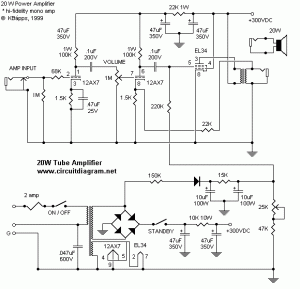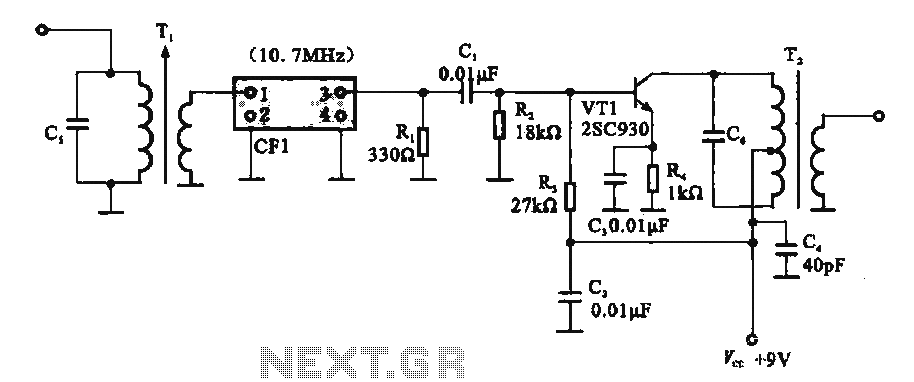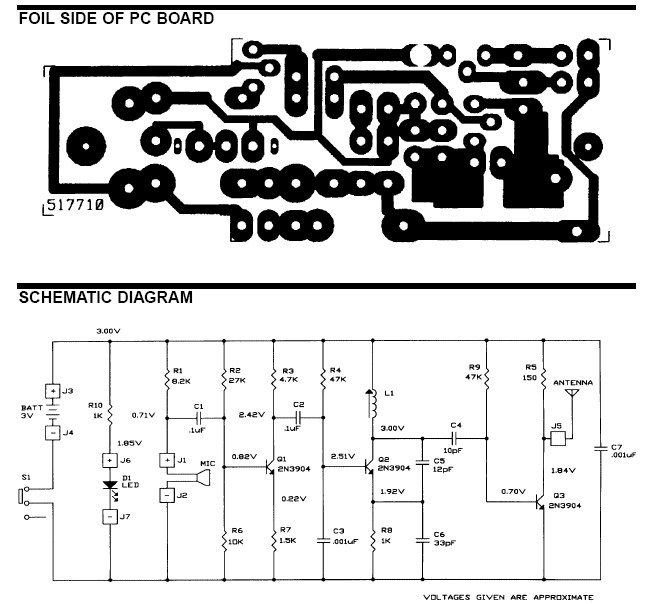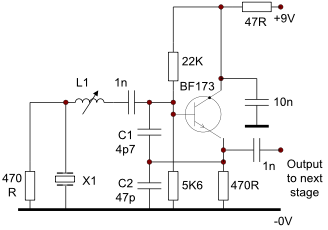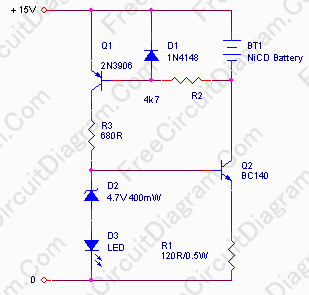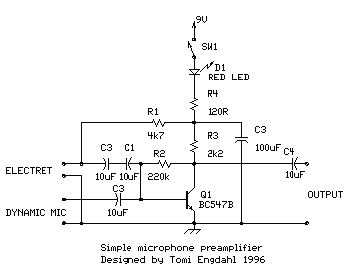
TDA2030 18W + 18W Stereo Hi-Fi Audio Amplifier circuit and explanation
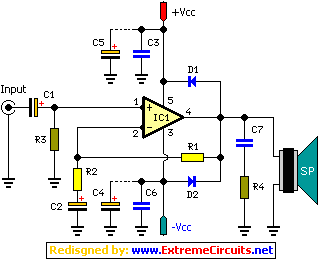
A 2 x 18W Hi-Fi Stereo Power Amplifier is designed using two TDA2030 integrated circuits (ICs). This amplifier features good input sensitivity, low distortion, stable operation, and comprehensive protection against overloads and output short-circuits. It can serve as a booster amplifier for existing small systems or drive an additional pair of speakers alongside those already connected. The circuit requires a symmetrical power supply of ±18Vdc/3A and is compatible with loads of 8 or 4 Ohms. A large heat sink is necessary for this design. The diagram provided illustrates only the left channel; two circuits are needed for a complete stereo version.
The 2 x 18W Hi-Fi Stereo Power Amplifier circuit utilizes the TDA2030 IC, which is renowned for its performance in audio amplification applications. The TDA2030 operates efficiently in a range of configurations, making it suitable for both home audio systems and small public address systems. Its low total harmonic distortion (THD) ensures high fidelity sound reproduction, which is critical in high-quality audio applications.
The amplifier's design emphasizes stability and reliability, featuring built-in protection mechanisms that guard against overload conditions and short circuits at the output. This is particularly important in scenarios where the amplifier may be subjected to varying loads or unexpected signal spikes, ensuring that the integrity of the connected speakers is maintained.
Power requirements for this amplifier are specified at ±18Vdc with a current capacity of 3A, necessitating a dual power supply arrangement. This symmetrical power supply configuration is essential for the proper functioning of the amplifier, as it allows the output signal to swing positively and negatively around a central ground reference, which is crucial for balanced audio output.
The circuit's compatibility with 4 and 8 Ohm loads broadens its applicability, allowing it to drive a variety of speaker configurations. The inclusion of a large heat sink is vital, as the TDA2030 can generate significant heat during operation, especially under high load conditions. Proper thermal management ensures that the amplifier operates within safe temperature limits, enhancing its longevity and performance.
For stereo operation, it is necessary to construct two identical circuits, one for each channel. The schematic diagram provided typically represents only one channel (left), and duplicating this setup will yield a complete stereo amplifier capable of delivering rich and immersive sound experiences.
Overall, this amplifier design is suitable for enthusiasts looking to enhance their audio systems with a reliable and efficient power amplification solution.2 x 18W Hi-Fi Stereo Power Amplifier based around two TDA2030 ICs. It has good input sensitivity, low distortion, good operating stability and full protection against overloads and output short-circuits. It can be used as a booster amplifier for existing small systems or to drive a second pair of speakers besides the ones already connected to the
system. The board needs a symmetrical power supply of ±18Vdc/3A and can be connected to loads of 8 or 4 Ohm. Large heat sink is required for this circuit. Diagram shown below indicates only left channel. Make two circuits for for stereo version. Disclaimer All files are found using legitimate search engine techniques. This site does not and will not condone hacking into sites to create the links it list. We will and do assume that all links found on the search engines we use are obtained in a legal manner and the webmasters are aware of the links listed on the search engines. If you find a URL that belongs to you, and you did not realize that it was "open to the public", please use the report button to notify the blogmaster of your request to remove it or it will remove within 24 hours.
This is not an invitation for webblog haters to spam with requests to remove content they feel that is objectionable and or unacceptable. Proof of URL ownership is required. NOTICE: This Blog Has Already Been Reviewed And Accepted By Blogger. com 🔗 External reference
The 2 x 18W Hi-Fi Stereo Power Amplifier circuit utilizes the TDA2030 IC, which is renowned for its performance in audio amplification applications. The TDA2030 operates efficiently in a range of configurations, making it suitable for both home audio systems and small public address systems. Its low total harmonic distortion (THD) ensures high fidelity sound reproduction, which is critical in high-quality audio applications.
The amplifier's design emphasizes stability and reliability, featuring built-in protection mechanisms that guard against overload conditions and short circuits at the output. This is particularly important in scenarios where the amplifier may be subjected to varying loads or unexpected signal spikes, ensuring that the integrity of the connected speakers is maintained.
Power requirements for this amplifier are specified at ±18Vdc with a current capacity of 3A, necessitating a dual power supply arrangement. This symmetrical power supply configuration is essential for the proper functioning of the amplifier, as it allows the output signal to swing positively and negatively around a central ground reference, which is crucial for balanced audio output.
The circuit's compatibility with 4 and 8 Ohm loads broadens its applicability, allowing it to drive a variety of speaker configurations. The inclusion of a large heat sink is vital, as the TDA2030 can generate significant heat during operation, especially under high load conditions. Proper thermal management ensures that the amplifier operates within safe temperature limits, enhancing its longevity and performance.
For stereo operation, it is necessary to construct two identical circuits, one for each channel. The schematic diagram provided typically represents only one channel (left), and duplicating this setup will yield a complete stereo amplifier capable of delivering rich and immersive sound experiences.
Overall, this amplifier design is suitable for enthusiasts looking to enhance their audio systems with a reliable and efficient power amplification solution.2 x 18W Hi-Fi Stereo Power Amplifier based around two TDA2030 ICs. It has good input sensitivity, low distortion, good operating stability and full protection against overloads and output short-circuits. It can be used as a booster amplifier for existing small systems or to drive a second pair of speakers besides the ones already connected to the
system. The board needs a symmetrical power supply of ±18Vdc/3A and can be connected to loads of 8 or 4 Ohm. Large heat sink is required for this circuit. Diagram shown below indicates only left channel. Make two circuits for for stereo version. Disclaimer All files are found using legitimate search engine techniques. This site does not and will not condone hacking into sites to create the links it list. We will and do assume that all links found on the search engines we use are obtained in a legal manner and the webmasters are aware of the links listed on the search engines. If you find a URL that belongs to you, and you did not realize that it was "open to the public", please use the report button to notify the blogmaster of your request to remove it or it will remove within 24 hours.
This is not an invitation for webblog haters to spam with requests to remove content they feel that is objectionable and or unacceptable. Proof of URL ownership is required. NOTICE: This Blog Has Already Been Reviewed And Accepted By Blogger. com 🔗 External reference
Warning: include(partials/cookie-banner.php): Failed to open stream: Permission denied in /var/www/html/nextgr/view-circuit.php on line 713
Warning: include(): Failed opening 'partials/cookie-banner.php' for inclusion (include_path='.:/usr/share/php') in /var/www/html/nextgr/view-circuit.php on line 713
